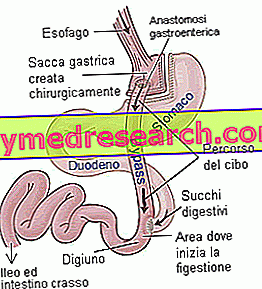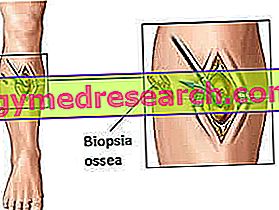What is gastric bypass
Gastric bypass (or Roux-en-Y) is the most common surgical procedure to combat severe obesity. The procedure determines a significant weight loss, thanks to a mixed action that combines a restrictive mechanical component with the induction of malabsorption; in practice, the intervention modifies both the anatomy (volume of the stomach and its relations with the intestine) and the gastrointestinal physiology (altering the processes of digestion and absorption of food).
The gastric bypass involves the creation of a small pocket in the upper part of the stomach, obtained by surgical resection of the organ (restrictive mechanical component).

The intervention obliges the patient to a considerable dietary limitation, due to the small size of the gastric pouch (about 20-30 ml of volume), which cannot physically accommodate large quantities of food. The reduction in gastric capacity favors an early feeling of satiety even after eating a moderate amount of food. Ignoring this stimulus by continuing to eat would result in vomiting and acid reflux on the one hand and problems like flatulence and diarrhea on the other
To all this is added the exclusion from the digestive processes of the distal stomach, the duodenum and other segments of the digestive system involved in the absorption of nutrients; this results in a reduced ability to absorb nutrients.
In essence, the subject subjected to gastric bypass will eat less and, for the same amount of food ingested, will absorb less nutrients and calories.
The extent of the bypass that affects the intestine, weighted by the surgeon before surgery, will determine the degree of malabsorption (mild or moderate). The standard Roux gastric bypass food loop is about 75 cm and on average produces a weight loss of around 60-70% of the excess body weight. The established weight objective is generally reached within two years, after which it is common to reach a long-term plateau: on average, patients maintain weight loss indicatively for 10-14 years. The recovery of part of the weight lost is not excluded, but this outcome is strongly influenced by the degree of adherence to the strict dietary and behavioral guidelines. In addition to weight loss, gastric bypass can help resolve conditions often associated with obesity and improve quality of life and the ability to perform normal daily activities. Many surgeons prefer to perform this procedure, as they generally have fewer complications than other bariatric surgeries. However, like other surgical operations, potential side effects and serious risks are not excluded. Also for this reason, gastric bypass should be considered only after an obvious failure of other methods, such as diet and exercise.
To whom it is addressed
Morbid obesity predisposes to a series of diseases that essentially affect every system of the body and carry a serious health risk. Gastric bypass surgery, in addition to inducing excess weight loss, can improve the potentially dangerous conditions associated with it. Therefore, gastric bypass is a valid option if:
- The body mass index (BMI) is ≥ 40 (very severe obesity).
- BMI is 35-40 and there are serious health problems associated with excessive weight, such as type 2 diabetes, hypertension or obstructive sleep apnea.
- All non-surgical measures to combat obesity (diet, psychotherapy, exercise and drug treatment) failed to produce a clinically useful weight loss in the medium / long term.
- The patient does not present any medical or psychological obstacles to surgery or to the use of anesthesia and shows a firm will to commit himself for a long period of post-operative follow-up.
Ultimately, gastric bypass is NOT a procedure suitable for all severely obese patients. All those concomitant diseases that significantly reduce life expectancy and cannot improve with weight reduction, including some cardiopulmonary diseases or terminal cancer, are contraindications to bariatric surgery. Even patients who do not intend to make permanent changes to their lifestyle and participate in post-operative follow-up plans are considered unsuitable for gastric bypass.
The procedure
The purpose of gastric bypass is to decrease the amount of food that the individual can ingest and at the same time reduce the absorption of the few nutrients ingested. The surgery is performed under general anesthesia, so the patient is not conscious during the procedure.
Roux-en-Y is the most common method of performing gastric bypass. The first step in the surgery is to create a small gastric pouch, obtained by resection of the upper part of the stomach. The surgeon will use staples to divide the stomach into a small upper section (pocket) and into a larger lower part; this operation is called pinching the stomach.
The gastric pouch makes the stomach small and limits food intake, as the patient feels early a feeling of satiety. The resulting gastric bag can in fact contain only 15-30ml of food (reducing the volume of the organ by more than 90%, which in normal conditions can reach and exceed two liters of content).
Subsequently, the surgeon undertakes a surgical technique called "Roux-en-Y": the gastric pouch, disconnected from the stomach and from the first part of the duodenum, is reconnected to the small intestine at the level of the jejunum, through a jejunal loop. After a Roux-en-Y, the food passes through the pocket of the stomach and reaches the fast directly, excluding a digestive tract responsible for the digestion and absorption of nutrients (part of the stomach, duodenum and biliary tract). This leads to a relative malabsorption of ingested food, which aims to reduce the amount of calories absorbed.
Generally, stomach resection and bypass are performed during the same surgery, which takes about 2-4 hours to complete. Bypass surgery is considered irreversible, but in some cases the procedure can be partially reversed.
Gastric bypass can be performed with two techniques:
- Standard approach (open): involves a laparotomy with incision of the abdominal wall;
- Laparoscopic approach: doctors insert special surgical devices, particularly thin, through 4-6 small cuts made on the abdomen; among these, there is a small camera (laparascope) that allows you to view the inside of the abdomen and to guide the various operations without resorting to traditional incisions. Laparoscopic surgery can make recovery faster by reducing risks, complications and hospital stay, but it is not suitable for all patients.
Gastric bypass allows a weight reduction of about two thirds of the excess body weight.
risks
Like any major surgery, gastric bypass has several potential health risks, both short and long term.
The risks associated with the surgical procedure may include:
- Adverse reactions to anesthesia;
- Emoragie;
- Infections;
- Blood clots (thrombosis and embolism);
- Respiratory problems;
- Death (rare).
Long-term complications may include:
- Abdominal pain;
- Bowel obstruction;
- Dumping syndrome, which causes diarrhea, nausea or vomiting;
- Gallstones;
- Nutritional deficiencies (deficiency of vitamins, minerals and electrolyte imbalance), with consequences such as osteoporosis due to calcium deficiency or iron deficiency anemia and / or vitamin B12 and / or folic acid;
- Perforation of the stomach, ulcers of the anastomosis (point of connection between the gastric pouch and the intestine) and intestinal hernias.
Dumping syndrome . After gastric bypass surgery, some patients may experience an intolerance to the intake of some sweet foods, especially when ingesting highly sugary liquids and concentrated fats. The dumping syndrome is caused by the altered function of the stomach, which causes a rapid passage of the gastric contents into the small intestine. The presence of simple sugars concentrated in the jejunal loop has a substantial osmotic load, which can cause discomfort and abdominal cramps. In addition, the resulting rapid release of insulin can cause hypoglycemia.
Symptoms of dumping syndrome include nausea, weakness, sweating, weakness, and occasionally diarrhea after eating. This unpleasant reaction is considered a characteristic side effect of gastric bypass.
Recovery after bypass
In general, the patient needs to stay in the hospital for about 1-4 days, in order to be monitored during the most delicate period after surgery. During the first week it will be possible to drink only liquids, to allow the stomach and digestive system to heal. The progression of the phases of adaptation to gastric bypass involves a specific diet for about 12 weeks, with the gradual re-introduction of solid foods. During this time various restrictions or limits are imposed on how much and what to eat and drink. First, it is necessary to avoid food with a high sugar content, such as chocolate, cakes, sweets and biscuits: the bypass, in fact, influences the "digestion" of sugar and can cause a series of unpleasant symptoms, collectively known as the syndrome of dumping (with nausea, abdominal pain and diarrhea). Secondly, on medical advice, it is necessary to take a multivitamin supplement daily that contains a combination of different vitamins and minerals, in order to compensate for the defect in nutrient absorption after gastric bypass. The most common disorders are anemia and osteoporosis, caused by poor absorption of iron and calcium. Undergoing regular medical checks, during post-operative follow-up, allows you to monitor health conditions and can reduce the risk that these disorders cause serious complications. Most people are able to resume normal activities within 3-5 weeks of surgery.
Gastric bypass surgery has an emotional and physiological impact on the individual. Many of those who have had a gastric bypass suffer from depression in the months following the surgery. Adapting to eating several small meals a day can be difficult for some people. Furthermore, severe diet limitations can cause great emotional tension and mood changes in the patient.
In the first three to six months after gastric bypass, some changes may also occur depending on how the body reacts to rapid weight loss, including:
- Muscle pains;
- Feeling tired;
- Dry skin;
- Thinning and hair loss.
Energy levels after surgery can be low, either due to the limitation in food intake or due to negative changes in the emotional state. Muscular weakness is also common in the months following surgery, due to a number of factors including protein restriction, the consequent loss of muscle mass and decreased energy levels. Many of these disorders tend to resolve when food intake gradually increases in the post-operative phase.
Gastric bypass has been shown to induce greater weight loss over the long term than that achieved with dietary, medical, behavioral or combined approaches.
Advantages
The main advantage of gastric bypass lies in its ability to help patients lose a significant amount of excess weight.
Each patient is unique, but a number of positive effects associated with weight loss are commonly recorded:
- Reduction of health risks associated with obesity (heart disease, hypertension, obstructive sleep apnea, type 2 diabetes, etc.);
- Improvement of physical and mental conditions: many health problems related to obesity improve or even disappear after gastric bypass surgery.
After the operation, weight loss requires motivation and permanent changes in a person's behavior: it is important to follow strict dietary guidelines and practice regular physical activity to maintain the results obtained with gastric bypass.



